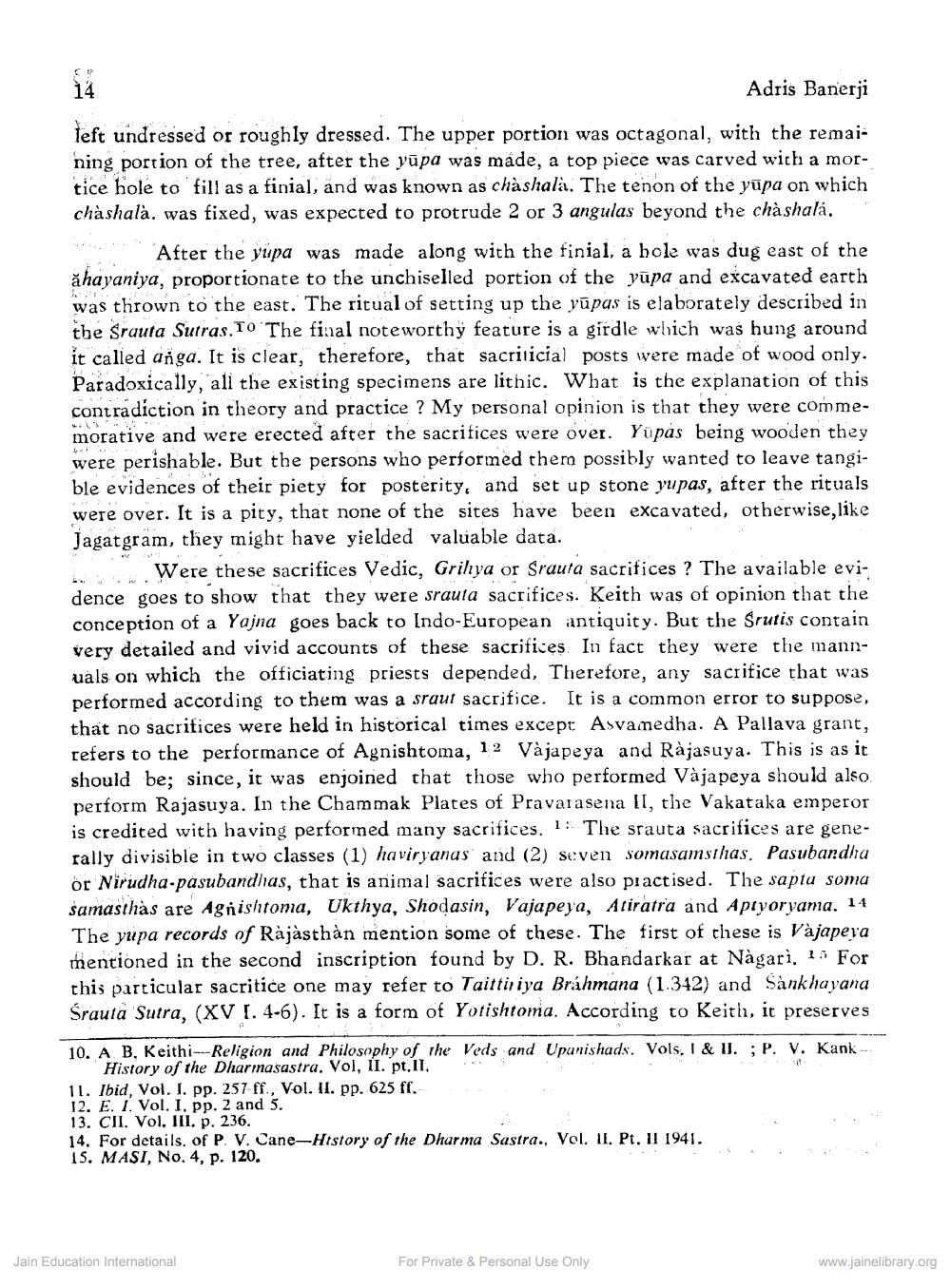Book Title: Religious Conditon in SE Rajasthan from early Inscriptions Author(s): Adris Banerji Publisher: Z_Jinvijay_Muni_Abhinandan_Granth_012033.pdf View full book textPage 4
________________ Adris Banerji left undressed or roughly dressed. The upper portion was octagonal, with the remaining portion of the tree, after the yūpa was made, a top piece was carved with a mortice hole to fill as a finial, and was known as chà shala. The tenon of the yüpa on which chà shalà. was fixed, was expected to protrude 2 or 3 angulas beyond the chà shalá. After the yupa was made along with the finial, a hole was dug east of the à hayaniya, proportionate to the unchiselled portion of the yūpa and excavated earth was thrown to the east. The ritual of setting up the yūpas is elaborately described in the Srauta Sutras. To The final noteworthy feature is a girdle which was hung around it called arga. It is clear, therefore, that sacrilicial posts were made of wood only. Paradoxically, all the existing specimens are lithic. What is the explanation of this contradiction in theory and practice ? My personal opinion is that they were commemorative and were erected after the sacrifices were over. Yüpas being wooden they were perishable. But the persons who performed them possibly wanted to leave tangible evidences of their piety for posterity, and set up stone yupas, after the rituals were over. It is a pity, that none of the sites have been excavated, otherwise,like Jagatgram, they might have yielded valuable data. Were these sacrifices Vedic, Grihya or Srauta sacrifices ? The available evidence goes to show that they were srauta sacrifices. Keith was of opinion that the conception of a Yajna goes back to Indo-European antiquity. But the Srutis contain very detailed and vivid accounts of these sacrifices. In fact they were the mannuals on which the officiating priests depended, Therefore, any sacrifice that was performed according to them was a sraut sacrifice. It is a common error to suppose, that no sacrifices were held in historical times except Asvamedha. A Pallava grant, refers to the performance of Agnishtoma, 12 Vàjapeya and Rajasuya. This is as it should be; since, it was enjoined that those who performed Vàjapeya should also perform Rajasuya. In the Chammak Plates of Pravarasena II, the Vakataka emperor is credited with having performed many sacrifices. 1: The srauta sacrifices are generally divisible in two classes (1) haviryanas and (2) seven somasamsthas. Pasubardha or Nirudha-pasubandhas, that is animal sacrifices were also practised. The saptu soma samasthàs are Agnishtoma, Ukthya, Shodasin, Vajapeya, Atiratra and Aptyoryama. 14 The yupa records of Rajasthan mention some of these. The first of these is Vajapeva mentioned in the second inscription found by D. R. Bhandarkar at Nagari. 15 For this particular sacritice one may refer to Taittiriya Brahmana (1.342) and Sankhayana Srauta Sutra, (XV I. 4-6). It is a form of Yotishtoma. According to Keith, it preserves 10. A B, Keithi --Religion and Philosophy of the Veds and Upanishads. Vols, I & U. ;P. V. Kank - History of the Dharmasastra. Vol. II. pt. II, 11. Ibid, Vol. I. pp. 257-ff., Vol. II. pp. 625 ff. 12. E. I. Vol. I. pp. 2 and 5. 13. CII. Vol. III. p. 236. 14. For details, of P. V. Cane-History of the Dharma Sastra., Vol. II. Pt. II 1941. 15. MASI, No. 4, p. 120. Jain Education International For Private & Personal Use Only www.jainelibrary.orgPage Navigation
1 2 3 4 5 6 7 8 9
